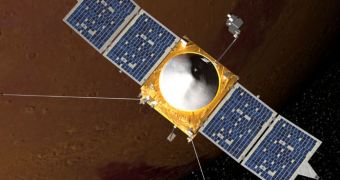Officials at the American space agency announced yesterday, October 21, that Littleton, Colorado-based United Launch Services, LLC (ULS) will be responsible for launching the upcoming MAVEN mission to the Red Planet.
The flight will include the Mars Atmosphere and Volatile Evolution spacecraft (MAVEN), which is currently tentatively scheduled to take off by November 2013, aboard an Atlas V 401 delivery system.
The agency plans to launch the new orbiter from the Cape Canaveral Air Force Station (CCAFS), in Florida. The facility is located right next to the Kennedy Space Center, the home of the shuttle fleet.
The new contract that NASA signed with ULS is estimated to worth about $187 million, and it includes, among others, tasks related to processing and preparing the Atlas rocket for flight.
Other services include payload processing, launch vehicle integration, and mission unique launch site ground support, as well as tracking, data and telemetry services.
NASA is launching the new orbiter specifically to analyze the upper layers of the Martian atmosphere, in order to get some answers to a bunch of long-standing mysteries about the Red Planet.
The most important questions concern the atmosphere and water that are believed to have once existed on Mars. They are nowhere to be found today, and MAVEN might help experts track them down.
Gases in the Martian atmosphere are believed to have played an important role in establishing the planet's climate patterns, and ultimately its transformation into the wasteland it is today.
MAVEN will also be capable of measuring how much of the atmosphere is currently escaping to space, in a study that will help researchers piece back what happened billions of years ago.
The project is managed by experts at the NASA Goddard Space Flight Center (GSFC), in Greenbelt, Maryland. The principal investigator for the mission is based in the Laboratory for Atmospheric and Space Physics at the University of Colorado in Boulder.
“A better understanding of the upper atmosphere and the role that escape to space has played is required to plug a major hole in our understanding of Mars,” says Dr. Bruce Jakosky, the MAVEN principal investigator.
“We’re really excited about having the opportunity to address these fundamental science questions,” adds the expert, who is based at the UCB-LASP.
“The team has successfully met every major milestone since selection two years ago. Looking forward, we are well positioned for the next push to critical design review in July 2011. In three short years, we’ll be heading to Mars!” adds GSFC MAVEN Project Manager David Mitchell.

 14 DAY TRIAL //
14 DAY TRIAL //